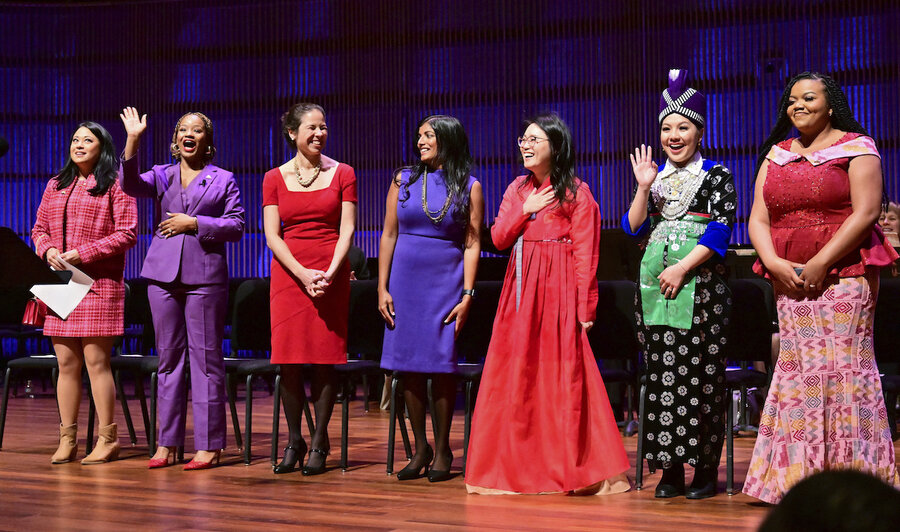In milestone for US cities, St. Paul’s new council is all women
Loading...
| St. Paul, Minn.
When St. Paul City Council President Mitra Jalali looked out at her fellow council members at their initial meeting this week, she saw all the members’ seats were occupied by women – a first for Minnesota’s capital city.
Experts who track women in politics said St. Paul, with a population of about 300,000 people, is the first large U.S. city they know of with an all-female city council. But even as the council members celebrate the milestone, they are expressing more excitement about what the all-female council can accomplish in the coming year.
“We’re a multifaith, multicultural group of women. Our professional experiences are what people trusted as much as our personal ones. … And we have a clear policy vision that we got elected on,” Ms. Jalali said in an interview.
All seven women are under 40 years old, and six out of the seven are women of color. From civil engineering to nonprofit directing, they have a wide range of professional experiences, which Ms. Jalali said helps capture the city’s diversity.
“I think that our community is finally reflected by the city council,” Ms. Jalali said, adding, “The median age of our community is 32.5. We are a majority person-of-color city. We have many major racial and ethnic groups, many of which are now represented on this council.”
According to researchers with the Center for American Women and Politics at Rutgers University, St. Paul is the largest U.S. city they are aware of to ever have an all-female city council.
The Rutgers data show that women continue to be underrepresented as municipal officials across the country. Jean Sinzdak, associate director of the center, said seven out of 10 municipal office holders across the country are male, and most of them are white.
“The fact that you have an all-female council and a majority of women of color, it has a long-term effect on young women and girls seeing them and saying, ‘I can do this, too,’ ” Ms. Sinzdak said.
Members held their first city council meeting Jan. 10 after getting sworn in the day before.
Hwa Jeong Kim, the council’s vice president, and Ms. Jalali said that their top priorities include a comprehensive housing policy, renter protections, climate action, public safety interventions that use police officers less and mental health responders more, and economic development.
“I feel like women and women of color and queer and trans women have been grieving for a long time – not for things that they’ve lost, but for things that they’ve never had,” Ms. Kim said.
The council “lifts up the progressive values of our community more than ever and is committed to doing that difficult work together – not just in a performative way, but in a way that is sustainable and will really make lasting change,” Ms. Jalali added.
The council is a nonpartisan office, but all seven members are Democrats, she said.
In Minnesota, women made up 35% of the municipal office holders in cities with over 10,000 people, tying the state with Michigan for 16th place among the 50 states, according to the Rutgers data. Alaska and Arizona had the highest proportions of women in municipal office at 45%. North Dakota had the lowest at 20%.
Ms. Sindzak said left-leaning and Democratic communities tend to have more women elected officials because Democratic women outnumber Republican women, so they are more likely to run for office.
“It’s not surprising to me that a city like this achieved this milestone first,” Ms. Sindzak said.
St. Paul is considered to be a Democratic stronghold.
Karen Kedrowski, director of the Carrie Chapman Catt Center for Women and Politics at Iowa State University, said the number of women elected to legislative, congressional, and municipal offices seems to consistently level off around 25% to 30% across the U.S.
“So to have a 100% female city council in a major city in the United States is really significant. If it’s not the first one, it’s one of the first where this has happened – so it’s a big deal,” Ms. Kedrowski said.
Ms. Kedrowski said Minnesota has tended to run ahead of the national average for the participation of women in elected office. Both of its U.S. senators are women, its lieutenant governor is a woman of color, and the Minnesota Legislature has a high percentage of women.
“What’s remarkable about this lineup is not just that it’s all women, but it’s the age of these women and it’s the diversity of these women,” said Heidi Heitkamp, director of the Institute of Politics at the University of Chicago and a former U.S. senator from North Dakota.
“It’s going to be a wonderful opportunity to see what diversity produces in terms of public policy, what things will change, because you have different people sitting at the table who traditionally haven’t had those roles,” Ms. Heitkamp said.
This story was reported by The Associated Press. Steve Karnowski reported from Minneapolis.







